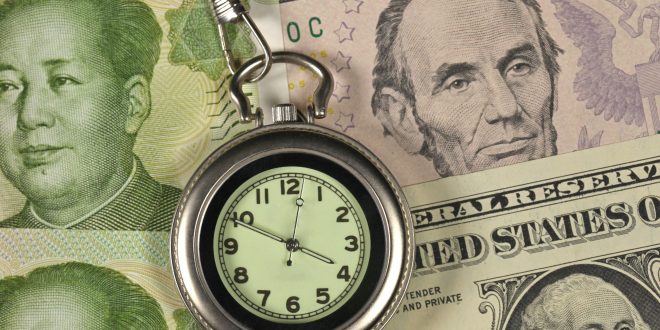The last week of January witnessed the first policy meeting for the United States Federal Reserve in 2021, one week following that of the European Central Bank (ECB).
The Federal Open Market Committee (FOMC) decided to maintain interest rates and the pace of the asset-purchase program both unchanged following a two-day meeting. Moreover, the Fed has reiterated its commitment to use all of its tools to support the American economy overcome the hardships resulting from the Coronavirus pandemic.
Prior to the meeting, the market saw huge anticipation for signals on when and how the American central bank will begin reducing the hefty bond buying. However, it seems that it will continue well until the end of year at least.
Meanwhile, the U.S. Congress is seeing increased efforts by the Democrats to pass the $1.9 trillion stimulus package proposed by President Joe Bides under the name “The American Rescue Plan.”
Both Senate Majority Leader Chuck Schumer and House Speaker Nancy Pelosi said that work to pass the relief package could begin next week.
The U.S. Treasury Secretary, Janet Yellen, has once again called upon Congress to pass the much needs stimulus bill, stressing the need of many Americans for support amid the pandemic.
Gold
After six consecutive declines, the yellow metal futures rose on Friday, but registered weekly and monthly losses. For the week, gold futures registered a loss of about 0.5%, while on the monthly level, gold futures lost 2.4% in January.
Gold’s decline came amid a rise in the U.S. Treasury yields.
However, it remains expected that due to the depreciation of the U.S. Dollar (USD), because of monetary easing policies coupled with increased government stimulus spending, that gold prices will rise on the long-term.
Oil
Crude oil prices ended the first month of the year in a positive way, registering weekly gains amid a positive sentiment towards the expected relief bill in the United States.
In addition, some supply disruptions and output cuts, supported by the OPEC+ alliance, are also providing a much needed support for oil prices.
The global benchmark, Brent crude futures gained about 0.9% for the week, and rose by 7.9% on the monthly level.
Meanwhile, the U.S. benchmark West Texas Intermediate (WTI) crude futures saw a small loss for the week at 0.1%, but rose by 7.6% during January.
An important indication of production levels, the number of active oil and natural gas rigs in the United States increased during the week for the tenth consecutive time, according to the weekly report by Baker Hughes. This marked the biggest number of increases in a row for the rig count since June 2018.
In addition, January marked the sixth consecutive monthly rise in the U.S. rig count by adding 33 rigs, which is the biggest monthly rise since October 2020.
Stock Market
Wall Street ended January with the worst losses for its benchmark indices since October 2020, amid increased concerns about a market bubble resulting from speculations on a number of small stocks.
Worries about the efficacy and the distribution of the Coronavirus vaccines also seem to be adding to the stock market woes.
The Dow Jones Industrial Average recorded weekly losses of 3.2%, while the S&P 500 and the Nasdaq Composite indices declined by 3.3% and 3.5%, respectively.
As for the monthly performance, the Dow Jones fell by 2%, S&P decreased by 1.1%, while on the other hand, the Nasdaq rose by 1.7%.
Calendar
The Corona pandemic continues to impede economic growth in major economies around the world.
In Germany, the Destatis report showed that the German economy expanded by 0.1% in the last quarter of 2020, compared to an expected 0% and 8.5% in Q3. The annual GDP rate decreased by 3.9% in the fourth quarter, compared to -4% market expectations.
In France, official data showed that the French economy contracted again in the last quarter of last year, but less than expected, this comes after the severe isolation measures taken by France to curb the Coronavirus. The National Institute of Statistics and Economic Studies reported that the second-largest economy in the euro area shrank by 1.3% in the last quarter, after rising by 18.5% in the previous one. This result falls short of expectations of 4% contraction.
In the UK, the official UK unemployment rate rose to 5.0% in November, from 4.9% and 5.1% previously expected, according to the Office for National Statistics data. The number of people claiming unemployment benefits rose by 7,000 in December, compared to 35,000 expected and 38.1 previously. UK Retail Sales also came in at 0.3% in December, versus 1.2% expected and -3.8% prior.
The Eurozone Manufacturing purchasing managers index (PMI) improved from 55.2 in December to in January and beat 54.6 expectations while the Services PMI dropped to in Jan vs. 45.0 expected and 46.4 last.
On the other side of the ocean, US gross domestic product expanded at an annual rate of 4% in Q4, following a 33.4% growth in Q3, in line with analysts’ estimates.
The Federal Open Market Committee (FOMC) on Wednesday announced that it left the benchmark interest rate, the target range for federal funds, unchanged at 0% -0.25% as widely expected.
In its policy statement, the Fed reiterated that it remains committed to using its full range of tools to support the economy.
In Canada, real GDP expanded by 0.7% in November, above market expectations of 0.4%.
U.S. dollar
The US dollar benefited from the market volatility last week, as the US dollar index rose to 90.55 versus 90.13 the previous week. The US dollar received support from Fed Chairman Jerome Powell’s comments at the press conference that followed the interest rate decision.
“Will continue to increase bond purchases by at least $ 80 billion per month of treasuries and $ 40 billion per month of mortgage-back-statement until substantial further progress made on maximum employment and price stability goals.” Said Powell.
 Noor Trends News, Technical Analysis, Educational Tools and Recommendations
Noor Trends News, Technical Analysis, Educational Tools and Recommendations





